Understanding Liquid Force in Kiteboarding Performance
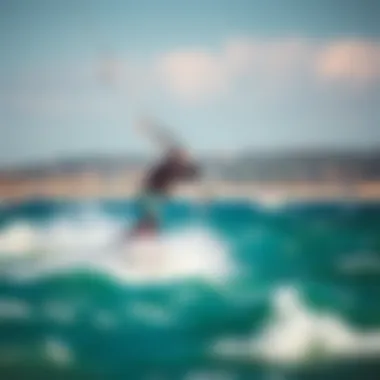
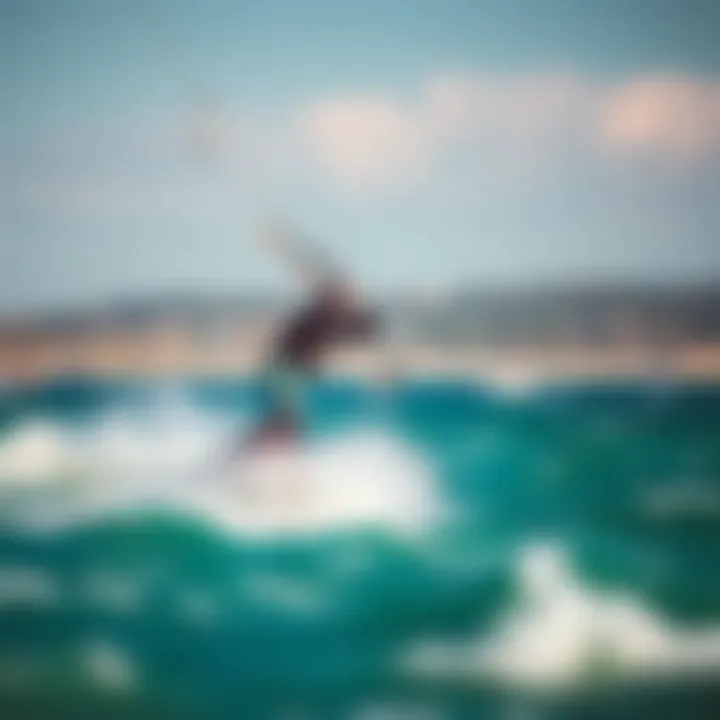
Intro
Kiteboarding, a thrilling blend of surfing and flying, demands an acute understanding of various forces at play, particularly the unseen yet impactful liquid force. This concept affects everything from performance and technique to safety on the water. The intricate dance between the kite and the water is more than just a symphony of waves and wind. It's about harnessing the energy within these elements to create a fluid riding experience.
Understanding the dynamics of liquid force allows kiteboarders, whether they're just starting out or are seasoned riders, to enhance their skills on the water, optimize their techniques, and ultimately, enjoy the sport to the fullest. With that in mind, let’s jump right into the vital aspects of equipment and techniques that will prepare you to master the liquid forces in kiteboarding.
Equipment Insights
Choosing the right gear can feel like finding a needle in a haystack, especially with the plethora of options available to modern kiteboarders. However, by focusing on certain key factors, you can select equipment that not only matches your riding style but also complements the natural dynamics of water.
Latest Gear Reviews
In the world of kiteboarding, staying updated with the latest gear is crucial. Top-tier brands like Naish, Cabrinha, and Duotone continuously innovate, offering new options that cater to various skill levels. For example, the Naish Pivot kite is well-regarded for its versatility and reliable performance, making it an excellent choice for both beginners and advanced riders aiming to push their limits. On the flip side, the Cabrinha Switchblade is favored for its stability, particularly in choppy water conditions, ensuring a smoother ride.
When evaluating new equipment, consider:
- Kite size and type: The right kite size can significantly affect your performance in different wind conditions.
- Board choice: Variations in shape and size impact grip, speed, and handling on water.
- Harness comfort: A good harness not only increases comfort but also plays a role in how effectively you can transfer force from the kite to the board.
It's essential to do your homework on kiteboarding forums, such as those found on reddit.com, where experienced riders share their firsthand gear reviews.
Essential Gear Maintenance
Keeping an eye on your equipment isn’t just good practice; it’s a lifesaver. Equipment not properly cared for can lead to unsafe situations, and nobody wants that out on the waves. Conducting routine checks for wear and tear should be part of your regular kiteboarding prep.
Here are some tips:
- Inspect your lines for frays or kinks; replace them promptly if any damage is found.
- Rinse your gear with fresh water after a session to prevent salt buildup.
- Store kites and boards in a cool, dry place, away from direct sunlight to prolong their lifespan.
Technique Exploration
Mastering the art of kiteboarding involves understanding various techniques that help riders effectively harness liquid forces. These techniques vary widely from beginner levels to more advanced maneuvers that can take years to perfect.
Beginner Techniques
For those just getting their feet wet, there are fundamental skills that should be prioritized. First and foremost is the kite control. Learning how to fly your kite at various angles is critical for managing power and maintaining stability while riding.
Once you're comfortable with kite control, practice these basic techniques:
- Water starts: The initial challenge of getting up on the board requires balancing the kite’s pull while keeping the board steady in the water.
- Riding upwind: This skill is crucial as it allows you to control your course. Being able to ride upwind means more time on the water and less dragging back toward the shore.
Advanced Maneuvers
As skills develop, kiteboarders can begin to explore advanced techniques that can elevate their riding. These include:
- Jumping: Understanding the mechanics of timing your kite's lift can create spectacular air moments.
- Transitions: Mastering smooth transitions between heel-side and toe-side riding helps maintain speed while adding flair to your style.
"Progress in kiteboarding is like trying to catch the wind – at times it slips right through your fingers, yet it is utterly rewarding when you finally learn to tame it."
For a deeper dive into the physics of kiteboarding and more tips from experts, check sources like britannica.com or en.wikipedia.org where you can find valuable insights.
Understanding Liquid Force
In the realm of kiteboarding, understanding liquid force is paramount for both performance and safety on the water. Liquid force embodies the interaction between the kite, the rider, and the element that holds them—water. This concept is not just a theoretical notion; it has real-world implications that directly influence how a kiteboarder maneuvers and performs various techniques.
Definition of Liquid Force
Liquid force can be defined as the resulting effect of a rider's actions in the water that influences thrust, stability, and the overall performance of the kite. It encompasses buoyancy, drag, and the dynamic movements of both the kite and the rider as they traverse the water's surface. Essentially, it is the push and pull that water creates against the board and the kite, shaping what becomes possible while kiteboarding. Understanding this force allows riders to make informed decisions about their movements, ensuring they harness this energy effectively.
Historical Context
The concept of liquid force in kiteboarding has evolved over the years. Originally, kiteboarding was a bit of an experimental sport. Riders were learning through trial and error, with minimal understanding of how water dynamics interact with their equipment.
Back in the late 1990s, as kiteboarding began to gain popularity, enthusiasts started to document their experiences and learn from each other. The technology of kites improved, leading to better performance and enabling riders to explore more complex techniques. In those early days, the integration of liquid force principles into kite design was rudimentary at best. As kiteboarders began to appreciate the role that liquid dynamics played, designs became more sophisticated, leading to innovative shapes and materials. This progression has made a significant impact, not only enhancing riders' experiences but also pushing the boundaries of the sport.
Today, understanding liquid force has become even more critical, especially for those who train professionally or instruct others. As the sport continues to grow, the need for precise techniques and knowledge of water interaction becomes clearer, establishing a direct connection between the rider's skill and their comprehension of liquid forces. This knowledge base serves as a foundation from which advanced maneuvers and safety practices evolve, ensuring that kiteboarding remains both thrilling and safe.
Physics Behind Liquid Force
Understanding the physics behind liquid force is crucial for kiteboarders looking to enhance their performance and riding techniques. Liquid force is the result of water dynamics that directly influence how a rider interacts with both their kite and the water's surface. By grasping the underlying principles, kiteboarders can make informed decisions about their maneuvers, safety strategies, and equipment selection. In essence, this knowledge arms riders with the ability to manipulate their performance, adjusting and refining their skills in real-time.
Fluid Dynamics Principles
Fluid dynamics is the study of how fluids behave when they are in motion or at rest. In kiteboarding, the behavior of water as a fluid plays a significant role in determining the forces acting on the rider and their equipment. When a kite is pulled forward, it creates a disturbance in the water, thus generating waves that can affect how a rider maintains balance and speed. The force exerted by these water currents can aid a kiteboarder in achieving greater lift or, conversely, can hinder their movement if not understood properly.
Key principles of fluid dynamics that kiteboarders should consider include:
- Streamlines: These indicate the path of fluid flow. Understanding these helps riders anticipate how water will interact with their equipment.
- Viscosity: The thickness or stickiness of the water can impact drag. Cooler water tends to be denser, affecting how a board glides.
- Reynolds Number: This dimensionless number helps classify the flow regime. A higher Reynolds number suggests a smoother, faster ride while a lower number indicates more turbulence, potentially affecting performance negatively.
By grasping these concepts, riders can manipulate their technique, optimizing their ability to harness every ounce of liquid force at their disposal.
Buoyancy and Drag
Buoyancy and drag are fundamental concepts in the physics of kiteboarding. Buoyancy is the upward force exerted by the water, which counteracts the weight of the rider and board. This force is pivotal because it allows the kiteboarder to float on the water's surface and aids in performing tricks and jumping.
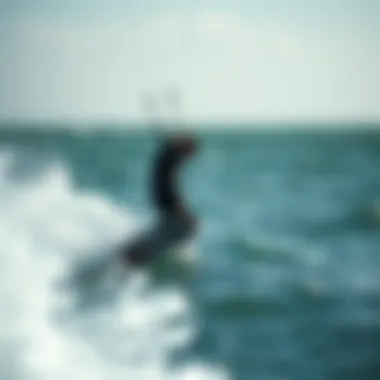
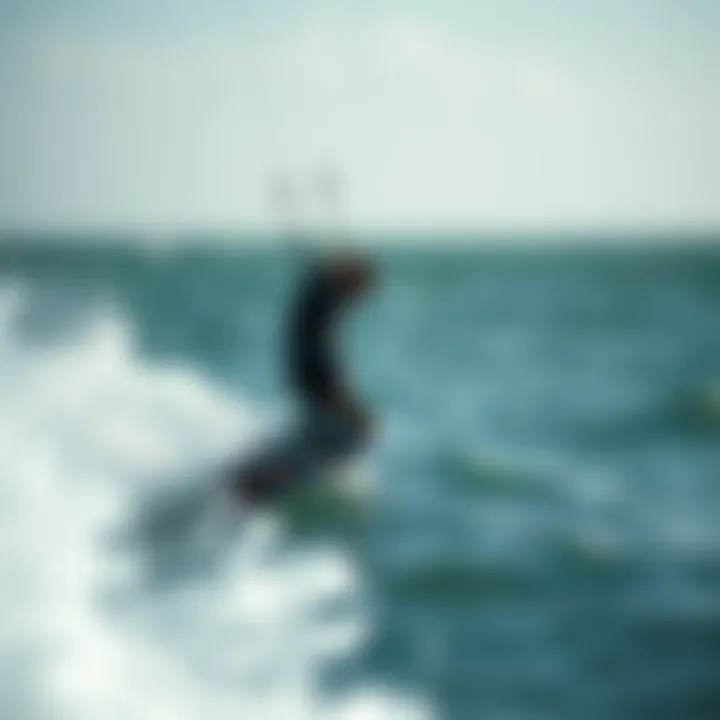
One important consideration is the board's shape and design. A wider board generally provides more buoyancy, allowing for easier floatation and stability, especially in choppy waters. This is particularly beneficial for beginners who may not yet have developed the finesse to balance on a narrower board.
Conversely, drag acts as a hindrance. As the rider moves through the water, the resistance they encounter influences speed and control. Here are some factors that can amplify drag:
- Board Shape: A broader base creates more surface area, which can increase drag during high-speed maneuvers.
- Surface Conditions: Choppy or rough water naturally increases drag, making it harder to maintain momentum.
- Kite Angle: The position of the kite relative to the wind can alter the amount of drag experienced by a rider.
As kiteboarders gain insight into buoyancy versus drag, they can adapt their techniques to minimize resistance while maximizing lift and performance in various water conditions.
Surface Tension Effects
Surface tension is the elastic-like force existing on the surface of water, caused by the attraction of water molecules. In the context of kiteboarding, surface tension can have noticeable effects on how a kiteboard glides over water and how the rider interacts with the water.
For instance, during the initiation of a jump, the surface tension can provide an added boost, allowing the rider to launch into the air more effectively. Understanding how to utilize these nuances of surface tension can lead to clever tricks and smoother transitions during maneuvers.
Some aspects of surface tension that kiteboarders should be aware of include:
- Wave Formation: Ripples on the water surface can affect how a rider takes off and lands.
- Splashing and Drag: When hitting the water with force, the surface tension can create more drag, disrupting balance and control.
- Water Aerodynamics: The flow of water will change based on the surface tension, influencing how the board reacts during rapid movements.
By learning how to leverage surface tension to their advantage, kiteboarders can improve their performance and ride more confidently on the water.
"The sea is a great teacher, revealing its secrets only to those willing to listen and observe its ways."
As a kiteboarder, being attuned to the physics of liquid force opens avenues for mastering various techniques and enhancing the overall riding experience. Comprehending these principles not only makes one a better rider but also deepens the connection with the elements at play.
Kiteboarding Techniques Influenced by Liquid Force
In the realm of kiteboarding, understanding how liquid force operates is crucial for mastering various techniques and enhancing overall performance. The prowess one displays on the water is largely dictated by the interaction between the kite and the water surface. When these components work in harmony, it elevates the entire experience. Here, we’ll dive into how the principles of liquid force shape essential kiteboarding maneuvers.
Launching and Landing
Effective launching and landing are pivotal moments in kiteboarding that can make or break a session. Mastery of these techniques is not just about skill; it’s about understanding the water's dynamics.
- Water Entry: When launching, the kite needs to create lift efficiently, utilizing the water's surface tension. The rider's position relative to the water affects the liquid force—too far back might cause a drag that can hinder take-off.
- Timing is Key: As the kite ascends, the water surface reacts. A solid launch involves synchronizing kite elevation with water conditions—knowing when to engage or ease off on the pull can mitigate unexpected splashes or, worse, potential crashes.
- Safety First: Landing, likewise, requires a finesse that considers liquid force. A smooth glide onto the water after a jump necessitates an understanding of how the kite's pull interacts with the water surface to soften the impact, minimizing strain on the body.
Launching and landing is not just about technique; it involves reading the water to achieve a seamless flow into and out of each session.
Turns and Jumps
The art of making swift turns and performing jumps relies heavily on an intimate understanding of the water dynamics. Kiteboarding is all about fluid transitions, and liquid force dictates how effectively riders navigate these changes.
- Carving Turns: When kiteboarders execute a turn, they need to lean into it while using the liquid force to their advantage. The combination of water resistance and kite pressure assists in maintaining momentum. If a rider approaches a turn too quickly without considering the liquid dynamics, they may find themselves struggling to maintain balance.
- Jump Technique: A well-timed jump needs to orchestrate power generated by the kite with the water's surface. Understanding how to use the water's buoyancy allows riders to achieve greater heights. For example, pulling slightly back on the harness while compressing against the board creates leverage to launch upwards, harnessing the push of the water beneath.
These maneuvers emphasize how crucial it is to adapt to the water’s characteristics while ensuring that the kite maintains its optimal position.
Tricks and Maneuvers
Tricks and maneuvers serve as the pinnacle of kiteboarding, with many riders aiming to showcase their skills through impressive aerial feats. However, executing complex tricks demands a keen awareness of liquid force, ensuring each move is fluid and controlled.
- Staying Grounded: Riders must know how each trick interacts with the water. For instance, during a backroll or a barrel roll, understanding the water’s reaction to the kite's movement can help ensure a successful landing.
- Consistency Over Chaos: Repeated practice of tricks allows riders to intuit the subtle variances in water conditions. This adaptability is the bedrock of mastery; recognizing how the flow of the water changes with the wind and personal technique contributes to performance.
- Innovative Moves: As the sport evolves, so does the complexity of tricks. The latest trends often emphasize smooth transitions that rely on harnessing liquid force effectively. Riders incorporating elements, like spins with variable speeds, must be exceptionally in tune with how water resistance can both help and hinder their movements.
Through mastering these foundational kiteboarding techniques, riders can better leverage liquid force for enhanced performance, control, and above all, the thrill of kiteboarding.
"Understanding the interplay between kite forces and water dynamics is not just beneficial; it's essential for every kiteboarder's journey."
By remaining aware of these elements, each kiteboarder—whether novice or expert—can enrich their experience and embrace the full spectrum of what kiteboarding has to offer.
Impact of Water Conditions
Understanding water conditions is key in kiteboarding. How water interacts with wind, tides, and temperature significantly affects performance and safety on the water. Kiteboarders must navigate through various challenges, and these challenges can dictate the success or failure of a ride. Knowledge in this area promotes better decision-making and enhances the overall experience. When mastering liquid force, appreciating the subtleties of water conditions is crucial.
Waves and Wind Interaction
Waves create a dynamic landscape for kiteboarders. They can build excitement or present hazard, depending on their size and structure.
- Small waves can enhance speed. As the board glides over them, it gains momentum, allowing riders to perform jumps and tricks with ease.
- Larger waves can create turbulence. This turbulence affects both the kite’s performance and the rider’s stability. It’s not unusual to witness experienced kiteboarders skillfully navigating through rough water, using the waves to their advantage.
When wind interacts with waves, a complex environment emerges. Wind can either amplify wave height or flatten them, depending on its direction and speed. A headwind, for instance, may slow down a rider, while a tailwind could launch them high into the air. Recognizing these interactions means not only embracing thrill but also ensuring safety.
"The secret lies in reading the water and embracing its rhythm. Knowing when to take a leap and when to hold back can make all the difference."
Tides and Currents
Tides and currents also play a substantial role in kiteboarding. The timing of a session can determine how favorable the conditions will be.
- High tides can wash away obstacles. They create cleaner take-off zones for jumps and allow easier navigation through localized channels. On the flip side, kiteboarding in low tides can present risks in shallow areas.
- Currents can either assist or impede progress. A downstream current might help a kiteboarder reach their destination more quickly, but it can also push them into dangerous zones. Knowing the flow of currents can prevent accidents.
For hands-on learners, consider joining local kiteboarding forums or groups. Engaging with experienced peers helps decode how local tides behave, providing insight into the best times to hit the water.
Water Temperature Considerations
Water temperature, though sometimes overlooked, can impact both performance and safety. Cooler water temperatures typically require more protective gear, whereas warmer ones allow for more flexibility.
- Colder water can lead to hypothermia, a serious risk that none should ignore.
- Warmer water can enhance comfort, but also increase the risk of dehydration. Heat can take a toll on stamina, leading to an increased likelihood of accidents.
Many kiteboarders choose to check water temperatures before heading out. Smartphone apps or websites providing up-to-date sea conditions can be invaluable. Understanding temperature fluctuations leads to better preparation, ensuring that riders enjoy their time on the water without the risk of unforeseen consequences.
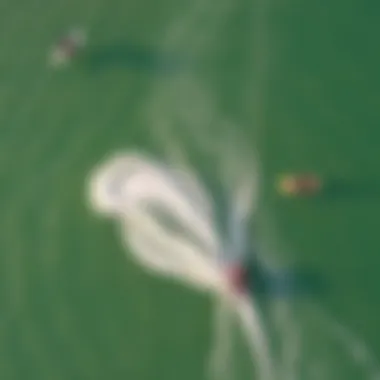
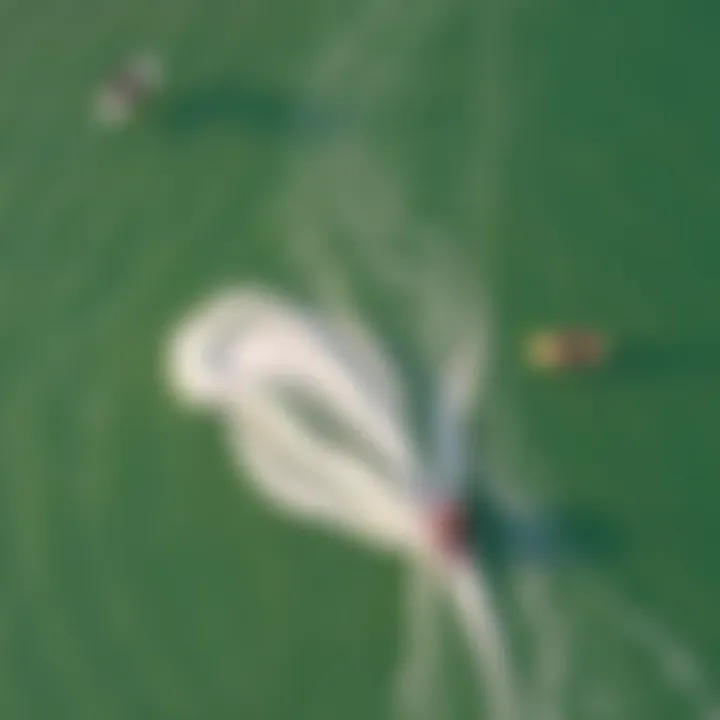
Equipment and Liquid Force
Understanding the role that equipment plays in kiteboarding is central to grasping how liquid force operates. The right gear does not only elevate performance; it fundamentally shapes the experience on the water. Each component—kites, boards, and harnesses—interacts with liquid force in specific ways, and comprehending these interactions can lead to enhanced safety and performance on the water.
Kite Design and Performance
Kite designs have evolved significantly over the years, with variations tailored to different wind conditions and riding styles. At the core of kite performance is the shape and material of the kite, both of which influence how the kite interacts with the wind and the water below.
- Shape and Size: A larger kite can catch more wind, providing more lift, while a smaller kite is more responsive and easier to control. Understanding these dynamics helps riders choose the appropriate kite based on their skill level, the water conditions, and the desired maneuvers.
- Materials: High-performance kites are typically made from ripstop nylon or polyester, designed for durability and minimal stretching. This ensures that the kite retains its shape and efficiency even in turbulent waters.
Ultimately, a well-designed kite assists in navigating the liquid force effectively, allowing riders to harness the power of wind and water without putting themselves at risk.
Board Selection
When it comes to selecting a board, understanding the relationship between the board's characteristics and the dynamics of liquid force is essential. Boards can vary greatly in design, each tailored for different riding styles—freestyle, wave riding, or racing.
- Board Size: A larger board provides more buoyancy, which can be advantageous in lighter wind conditions. On the contrary, a smaller board is better suited for tricks and high-speed maneuvering. Riders must match the board size with their skill level and the expected water conditions.
- Shape and Rocker: The board's shape, including its rocker line, affects how it interacts with the water. A flatter board offers speed and stability, while a more curved board excels in maneuverability and can navigate choppy waters more effectively.
By selecting the appropriate board, riders can enhance their control and responsiveness against the underlying liquid force, allowing for a more enjoyable ride.
Harness Mechanics
The harness may often be overlooked, but it plays a vital role in transferring the kite's force to the rider effectively. The design and fit of a harness can significantly impact comfort and control.
- Types of Harnesses: There are two main types of harnesses: seat and waist. Seat harnesses provide more support for the lower body and are usually recommended for beginners, while waist harnesses allow for more freedom of movement, making them popular among experienced riders.
- Adjustability: It’s important for the harness to fit snugly without being overly restrictive. Many modern harnesses come with adjustable straps, catering to various body types and allowing more customized comfort.
A well-fitted harness ensures that the rider can comfortably manage the forces exerted by the kite, making it a fundamental piece of equipment in kiteboarding.
A kite's performance is only as good as the gear you choose—make your selections wisely to harness the liquid force effectively.
To truly excel in kiteboarding, it's crucial for riders to understand the significance of their equipment in relation to the dynamics of liquid force. A tailored combination of kite, board, and harness not only enhances performance but also greatly contributes to the overall safety of the rider.
Safety Precautions in Kiteboarding
Kiteboarding is an exhilarating sport, mixing the thrill of surfing with the grace of flying a kite. Yet, this unique combination can also lead to dangerous situations if proper precautions are not taken. Focusing on safety in kiteboarding can prevent accidents and ensure a more enjoyable experience on the water. The essence of maintaining safety lies in understanding the specific risks associated with liquid force and the environment.
Understanding Risks Related to Liquid Force
Liquid forces significantly shape a kiteboarder's experience, both positively and negatively. Among the most critical risks to consider is how varying water conditions can affect the power of the kite. Strong currents, sudden waves, or even sharp changes in water depth can catch an unsuspecting rider off guard.
"The ocean is both a playground and an obstacle course, with every ride offering a different set of challenges."
Furthermore, the interaction between kite and water creates risks like tangling with the lines, which can lead to crashes. Riders should continuously assess their surroundings to identify potential hazards, such as rocks or submerged debris, which can exacerbate the force exerted by the water.
- Key Risks:
- Strong currents and waves
- Water depth changes
- Tangled kite lines
- Hidden aquatic hazards
Understanding these dynamics not only enhances performance but also reduces the potential for accidents, making it a crucial area of focus for any kiteboarder.
Proper Safety Gear
Wearing the right safety gear can be the difference between a minor mishap and a severe injury. Essential equipment includes the harness, life jackets, and helmets. A quality harness ensures the rider maintains control over the kite, while a life jacket can provide buoyancy in case of emergency.
Moreover, helmets protect against head injuries resulting from falls or collisions. Despite the rush of adrenaline, it's vital to prioritize safety; after all, no one enjoys a ride from the hospital. Here’s a rundown of vital safety equipment:
- Harness:
- Life Jacket:
- Helmet:
- Impact Vest:
- Ensures control and stability
- Provides buoyancy and safety support
- Protects against potential head injuries
- Additional padding for rough landings
Choosing gear that fits well and is designed specifically for kiteboarding can greatly enhance safety and performance on the water.
Emergency Procedures
Even with all precautions in place, emergencies can occur. Knowing what to do in a crisis situation is essential. First, kiteboarders should practice a quick and efficient self-rescue method such as the "kite down" technique, which involves ditching the kite safely if caught in a dangerous situation.
Additionally, having a plan for various emergencies, like sudden weather changes or equipment failure, can save lives.
- Emergency Procedures to Know:
- Self-Rescue: Quickly deflate the kite and paddle to safety.
- Signal for Help: Use a safety whistle or wave arms to signal other riders.
- Avoid Panic: Remain calm, as panic can cloud judgment.
Each rider should communicate their plan with their fellow kiteboarders before heading out. Being aware of one another can significantly enhance security on the water, as teamwork is vital in emergencies.
Environmental Considerations
Understanding the environmental considerations in kiteboarding is crucial for both the sport and those who participate in it. As kiteboarders navigate the water, they are inherently impacted by the conditions of their surroundings. This section delves into how pollution, sustainable practices, and monitoring techniques play significant roles in shaping a kiteboarder's experience while promoting a healthy relationship with nature.
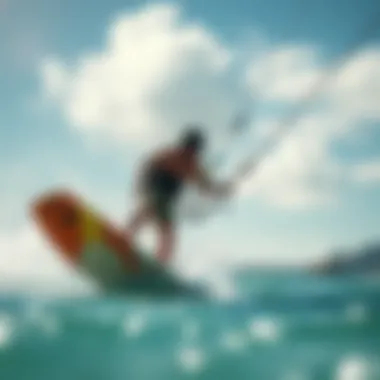
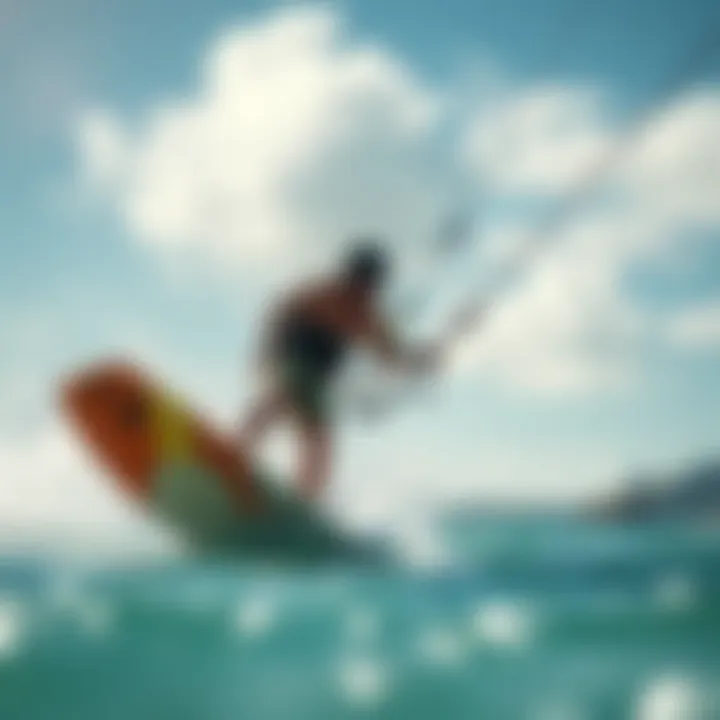
Pollution and Its Effects on Liquid Force
Pollution can have a profound effect on the dynamics of liquid force. Contaminants in the water disrupt not only the physical properties of the liquid but also the overall experience of kiteboarding. Debris, oils, and even microplastics alter water density and flow, influencing how a kite reacts while airborne. This can make launches feel different, and landings less predictable. A polluted environment may lead to increased drag, affecting the glide of the board, making it harder to perform tricks or maintain speed.
Moreover, pollution introduces health risks. For kiteboarders, exposure to harmful substances poses a significant threat. Skin irritation and respiratory issues may tarnish what is otherwise a thrilling endeavor on the water. Therefore, understanding local water quality is not only essential for enhancing performance but also for the safety of the rider.
"Clean water is like a clear sky for kiteboarders; it maximizes our potential to soar and enjoy the ride."
Sustainable Practices for Kiteboarders
Sustainable practices are vital for the longevity of kiteboarding as a sport. Kiteboarders have the unique opportunity to foster a connection with the environment, and their choices can either harm or help the ecosystem. Here are some practical actions riders can take:
- Choosing eco-friendly gear: Opting for kites and boards made from recyclable materials can reduce the ecological footprint.
- Clean-ups and Awareness: Participating in local beach clean-ups not only helps combat pollution but also raises awareness around the importance of keeping waterways clean.
- Educating Fellow Riders: Sharing knowledge about the need for sustainable practices allows for a wider impact, encouraging a collective approach toward environmental preservation.
- Mindful Travel: When exploring new kiteboarding locations, being conscious of local wildlife and delicate ecosystems helps maintain the natural balance.
Monitoring Weather and Water Conditions
Being aware of weather and water conditions is paramount for kiteboarders. Beyond just being pivotal for safety and performance, actively monitoring these factors can enhance the overall experience. Key aspects to consider include:
- Wind Patterns: Understanding local wind patterns can significantly influence kite choice, allowing for better control and maneuverability.
- Tide Movements: Knowing tide schedules helps in avoiding strong currents and choosing optimal launch and landing spots.
- Water Temperature: This can affect equipment choice and rider comfort. Cold water may necessitate protective gear, while warm waters often demand hydration considerations.
Ultimately, integrating these environmental considerations into the kiteboarding routine encourages a more mindful enjoyment of the sport. Riders who engage with the ecosystem respect the very waters that nourish their passion. These factors don’t merely impact performance; they contribute to a more sustainable future for all who ride the waves.
Future Innovations in Kiteboarding
The landscape of kiteboarding is in constant motion, mirroring the very water that kiteboarders harness for their exhilarating experiences. Future innovations in kiteboarding promise to transform everything from equipment design to training methods, ultimately enhancing both performance and safety on the water. As we delve into this dynamic frontier, we will explore how cutting-edge technologies and adaptive strategies will shape the next generation of kiteboarding.
Emerging Technologies in Equipment
Advancements in materials science and engineering have led to significant breakthroughs in kiteboarding equipment. Nanomaterials are paving the way for lighter, more durable kites. For instance, kites made from Dyneema fibers are not only incredibly strong but also resistant to stretching, giving riders confidence in their gear even in challenging conditions.
Moreover, the rise of smart technology in kiteboards is turning heads. Some boards now feature built-in sensors, designed to monitor environmental conditions and rider performance. This data can be relayed to mobile apps, allowing kiteboarders to adjust their techniques in real-time based on wind speed and water conditions.
Benefits of Emerging Technologies
- Improved Performance: Enhanced materials lead to increased lift, speed, and maneuverability.
- Durability: Cutting-edge equipment can withstand harsh conditions, extending the lifespan of gear.
- Real-Time Feedback: Smart technology can help speed up learning curves for new kiteboarders.
Considerations
While the future of kiteboarding equipment looks bright, kiteboarders should be aware of the potential costs associated with these innovations. High-tech boards and kites may come at a premium, demanding a balance between performance and budget.
Advanced Training Techniques
As kiteboarding evolves, so too must the ways we teach and learn the sport. New training methodologies focus on personalized, data-driven strategies that cater to individual skill levels. Utilizing video analysis software, instructors can evaluate a rider's technique in detail, pinpointing areas for improvement.
Virtual reality (VR) is also making waves in the kiteboarding community. By simulating conditions, VR training programs allow riders to practice maneuvers without the risks associated with the water, fostering better fundamental skills before hitting the waves.
Key Aspects of Advanced Training Techniques
- Video Analysis: Enables targeted feedback and adjustment.
- Simulation: Provides a safe environment to learn complex maneuvers.
- Individualized Programs: Tailors training to suit each rider's unique aspirations and challenges.
Research and Development Trends
Research into kiteboarding technology and techniques has gained traction in recent years. Universities and institutions are increasingly engaged in studying the dynamics of water interaction, aiming to develop efficient designs. Studies often focus on the fluid dynamics that govern how kites lift and how boards glide through water, providing valuable insights for manufacturers.
Furthermore, collaborations between kiteboarding brands and academic institutions are on the rise. These partnerships not only push the boundaries of innovation but also ensure that safety and environmental factors are considered in equipment design.
Noteworthy Trends to Watch
- Sustainable Materials: As the focus sharpens on environmental impact, lightweight and recyclable materials are becoming more prevalent in product lines.
- Wind Management Systems: Innovations that automate kite depower may enhance safety, allowing riders to better control their speed and elevation.
- Community Engagement: Social platforms are being utilized to gather rider feedback on products, enhancing the development process.
*"The future of kiteboarding is bright, but it requires an adaptive mindset and a willingness to embrace change for both safety and performance."
Case Studies: Liquid Force in Action
Understanding how liquid force operates within the realm of kiteboarding is not merely academic—it's crucial for practical applications on the water. Case studies serve as a bridge between theory and practice, providing tangible examples that illustrate complex concepts. By examining specific instances where liquid force played a pivotal role, both learners and experienced kiteboarders can gain insights that might otherwise remain elusive.
Analysis of Notable Events
Throughout the history of kiteboarding, several noteworthy events highlight the intricate dynamics of liquid force. For instance, consider the renowned Kiteboarding World Championships held at the stunning location of Pingtan, China. During this competition, participants were met with unseasonably high tides and powerful currents that significantly influenced performance across the board.
This event illustrates how conditions such as tide height can alter the fluid dynamics at play. As kiteboarders launched into the waves, those who adapted their techniques—modifying their timing to capitalize on the incoming swells—tended to outperform their counterparts. In contrast, those who failed to adjust often found themselves navigating unpredictable water flow, making it difficult to maintain speed and control.
- Key Takeaway: Adapting to water conditions can be the difference between victory and defeat.
Furthermore, we observe the case of a local kiteboarding community that faced extreme weather during a competition. Powerful gusts winds paired with sudden drops in air pressure resulted in challenging water conditions that demanded exceptional skill from competitors. The interplay of liquid force with wind dynamics led to fascinating displays of agility, pushing athletes to harness their kites against intense forces of nature. The outcomes varied, but the common theme was a commendable response to unexpected environmental changes, highlighting the importance of understanding liquid force.
Influential Kiteboarders' Experiences
Real-life experiences from seasoned kiteboarders offer profound perspectives about liquid force. One prominent kiteboarder, known for pushing the envelope in performance, shared that his success in competitions often stems from comprehending the nuances of water behavior.
He remarked, "It's not just about the kite or the board; it's how you read the water. Liquid force can either be your best friend or your worst enemy. Knowing when to pull back during a heavy gust while maintaining optimal speed is key."
Another professional, competing globally, detailed her transformation when she began to study and apply the principles of liquid force to her techniques. Simply put, the more she understood how water interacted with her equipment, the better she became.
- Insight from Professionals: Adapting your approach based on water dynamics can elevate performance to new heights.
In her experience, she noticed marked improvements in her ability to execute jumps and tricks upon recognizing how pressure beneath the board and the pull from the kite worked together. Each successful maneuver built her confidence further, helping her grasp the balance of liquid forces in her daily practice.
"Every wave is a lesson; every gust is an opportunity—if you’re willing to listen and adapt, you'll continuously evolve as a kiteboarder."
In summary, the case studies presented provide a clear picture of liquid force in action, showcasing its significance for those engaged in kiteboarding. By recognizing patterns from notable events and learning from the experiences of influential kiteboarders, aspiring riders can enhance their skills and better navigate the complexities of this exhilarating sport.







